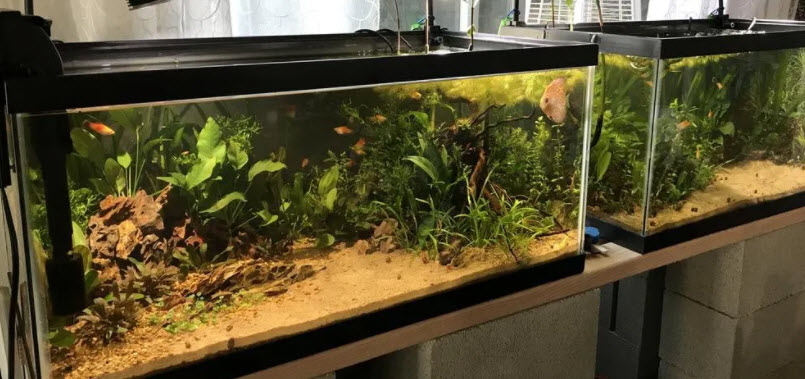
Good aeration in an aquarium is not a result of good water surface “movement”. It is the result of “surface turbulence” or “bubble turbulence”. The term “turbulence” refers to chaotic rapid movement of water in several directions at once, like the water movement in a rapids. Other ways of describing “surface turbulence” are “breaking the surface tension”, “choppy waves” or “surface agitation”. The “bubble turbulence” of many small rising bubbles also works well.
We go into depth on the science behind aeration with turbulent flow below. This wordy section is only for real nerds like the author.

The Complicated Science
There is a science field called “rheology”. In this field there is a very important number called a “Reynold’s number”. If the flow of water at an interface with air is fast enough to exceed the Reynold’s number for water, then the flow is very chaotic and turbulent. This is the type of flow which give good aeration.
Choppy water or water where the surface tension has been “broken up” are turbulent flow. When the flow is slower it is “laminar flow” (sometimes called “lamellar”). Laminar flow gives a smooth water surface with much less aeration taking place. Smooth flow and small ripples are laminar flow. In this case there is no “gray area”. Water flow is either turbulent or laminar. There is no gradual change between turbulent and laminar. This difficult concept is actually quite simple:

The concept is easy to see on the surface of the water:
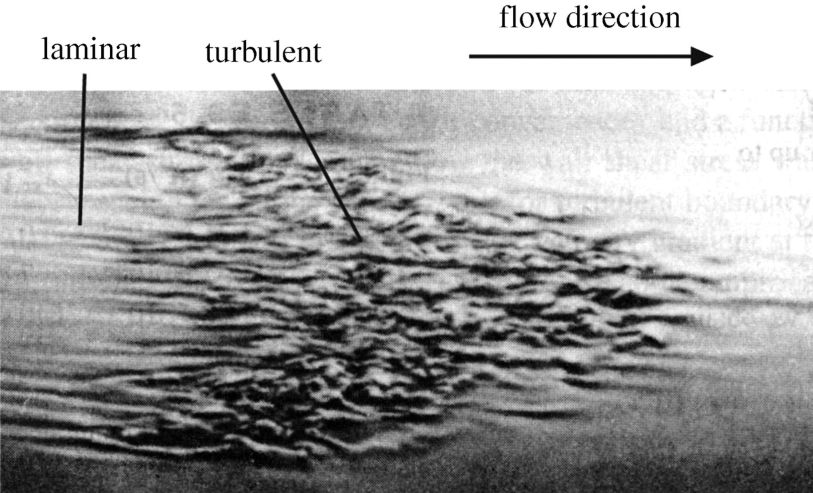
The laminar flow gives only slight aeration while the area of turbulent flow gives excellent aeration.
A great example of this turbulent flow and its effect on an aquarium is the following:
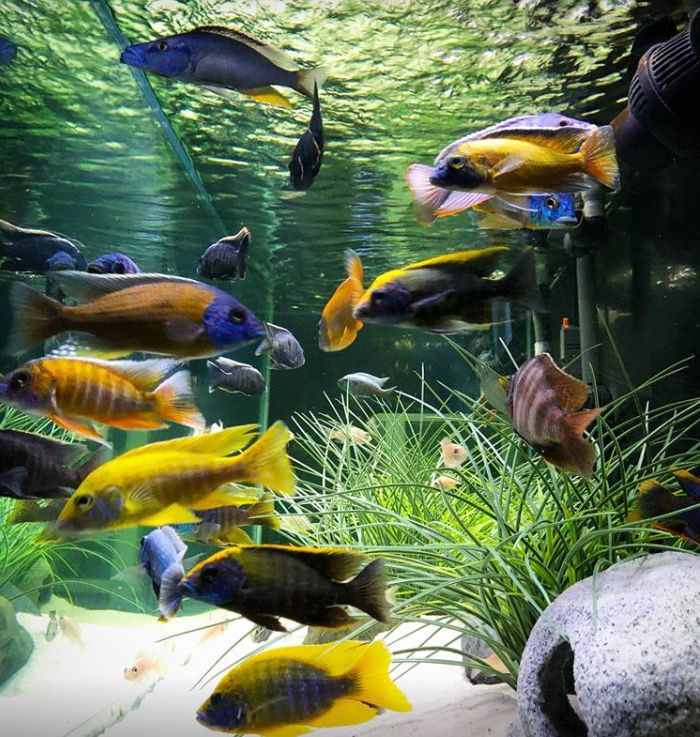
Notice how the surface of the water is choppy waves. This is turbulence and will give excellent aeration and crystal-clear water. Look at the fish six feet down this aquarium. It can be seen as clear as the one right next to the glass.
The turbulence at the air/water interface in an aquarium is very important for aeration. This interface is where the oxygen gas exchange takes place. The more the surface water turbulence the more exchange takes place. It is optimum to have water pumps and filtration returns situated to maximize the water’s surface turbulence. It is important to note that turbulence and speed are not synonymous here. You want high turbulence.
Small bubbles rising through the water each have a small area of turbulent flow associated with them. This turbulent flow aerates very well. So a lot of small bubbles rising though the water give very good aeration, contrary to popular myth. We cover that is the section on air stones.
9.3. Air Stones
.

What is important is turbulence. Both many rising bubbles and vigorous surface turbulence over a wide area gives good aeration. This turbulent flow is very important. Ben Ochart turned the canister return feeds in his aquariums down one night and turned off his circulation pumps to “give his fish a rest”. In the morning he had an aquarium full of dead fish.
It is obvious that a setup that creates a rapid turbulent flow of the surface down the length of the aquarium is optimum for aeration. But some fish hate this. In my experience small fish and sedate, slow-moving fish hate it. Don’t do it with tetras, discus or angelfish. But African cichlids and rainbowfish love it.
The ideal if the aquarium inhabitants don’t like high flow rates is to impinge several different pump flows against each other and against the walls of the aquarium. Don’t flow the flow down the length of the aquarium. Run the flows across the width of the aquarium, impinging against each other at 90 to 180-degree angles wherever possible. This will give much better surface turbulence without creating unwanted high currents in the aquarium.
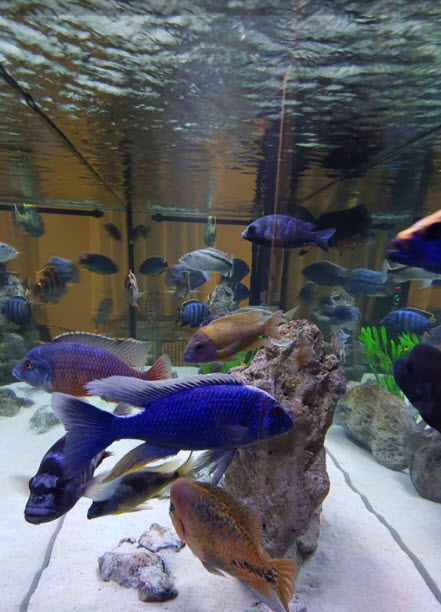
If one is aerating with the output of a powerhead or the output from a canister or sump filter, the outlet should be set up to maximize the water turbulence at the surface of the aquarium. It should have a duckbill or fan nozzle on it with the fan pointing up at the surface about twenty degrees off the horizontal. The nozzle needs to be about two inches below the water’s surface. This creates an optimum amount of turbulence for good aeration.
A bladed fan circulation pump exit which has a horizontal discharge right at the surface of an aquarium can do a reasonable job of aeration as there is a lot of surface turbulence induced.
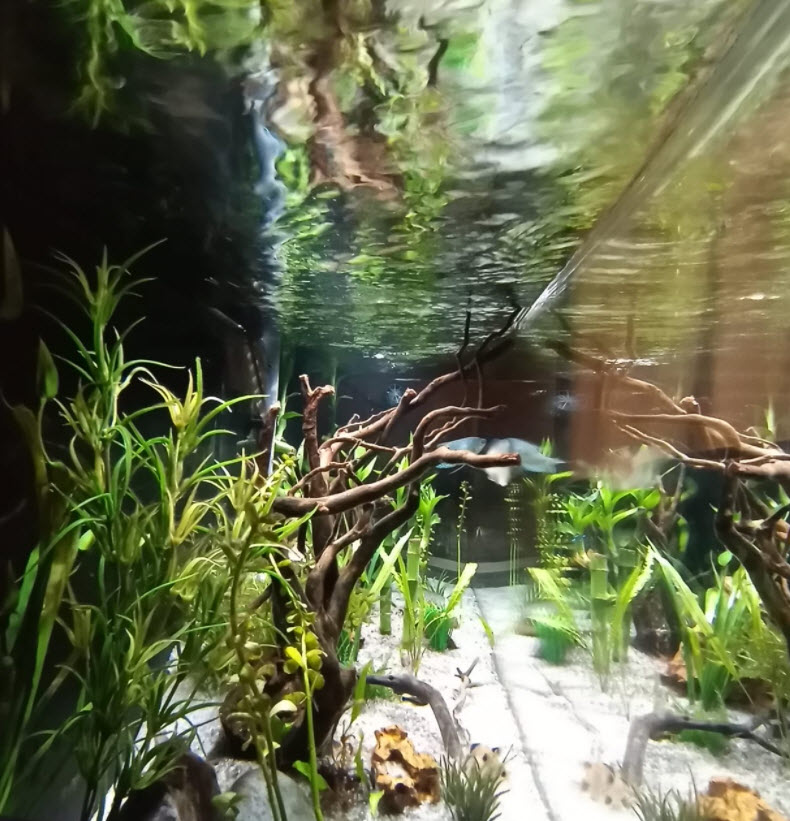
A powerhead or a circulation pump discharge which is horizontal two or more inches below the surface becomes much less of an aerator. This is also true for canister or sump filter outlets which simply flow their water into the aquarium through a pipe flowing out horizontally or vertically well below the surface of the water.
The water flow from hang-on-back filters is somewhat complicated. A “standard” HOB shoots the water directly down into the water, creating very little surface flow or aeration. The biowheel variation improves the aeration. Also, some HOBs have a lip which flows the water out horizontally right at the aquariums surface. This considerably increases the surface turbulence and the aeration.
Obviously if a sump filter is used all the above and more applies. The sump can have a trickle filter which gives excellent aeration. The sump can also have some air stones in it giving aeration. And of course a fluidized bed will give great aeration. And finally, the discharge into the aquarium can give good aeration if surface turbulence is created by the outlet.
.
Return to Aeration Menu
.
Aquarium Science Website
The chapters shown below or on the right side in maroon lead to close to 400 articles on all aspects of keeping a freshwater aquarium. These articles have NO links to profit making sites and are thus unbiased in their recommendations, unlike all the for-profit sites you will find with Google. Bookmark and browse!
.

Derek Debowski says
I have used fans to cool my tanks quite a bit as I keep my fish in a garage that gets very warm in the summertime. It has been very effective for me but it is worth mentioning that cooling effect is due to evaporation and on very warm days I can almost watch the water levels in my tanks recede. I ran into a lot of problems initially by not being careful to top off with RO water. A ton of evaporation can concentrate everything dissolved in your water pretty quickly. Just sharing my mistakes here not providing any advice.
Dave says
In reply to Yan …. Yes a fan will create cooling and aeration for any aquarium if aimed at the top surface. Now I’ve never needed cooling in any of my aquariums so I have no experience with it.
Yan says
HI Dave, I was looking for a solution to chill a little 5 gallons tank and found that a fan can be use to drop the temperature a couple of degrees.
Does a fan can help to create turbulence and aeration? Have you used fan to cool your tanks?
Dave says
In reply to Brad ….. absolutely no idea what the difference will be
Brad - UK says
Hi Dave,
Interesting question for you!
If fish required 30 inches/2 per pound of turbulent surface agitation to create good aeration, what would the equivalent be per pound of fish with a) no surface agitation or b) laminar (ripple) type agitation?
Is there a method to calculate the difference?
Thanks,
Brad
Dave says
Jingo …. The bubbles bursting do nothing. Aeration is the result of choppy waves and turbulent flow.
Jingo Saputra says
Sorry to ask, does lot of water bubble that burst / popped above water surface on a tank, it’s then called the result of proper surface agitation ?
I’ve try to use 1 powerhead, mounted on UGF plate, on 15 gallon tank ( 60 litre ), and using duckbill to orient the water flow towards surface. The duckbill itself positioned approximately 2 inch below surface.
But I think the result, although the water movement on surface quite good, but without bubble burst, only water ripples -> This result in no water stain on my tank lids.
If I change the position of the duckbill precisely on water surface, there are lot of bubble burst on water surface -> Resulting lot of water stain on my tank lids.
Oh, and on this 15 gallon tank, only one fish, albino gourami about 4-5 inch long.
Thank you very much.
Dave says
In reply to Sammy … Just try various configurations and see which one is best. There are just too many variables to make any sort of predictions.
Sammy Savill says
Would I get better aeration if I turned one of 2 UGF plates to opposite sides so the lift tubes were in opposing corners (say 10 o’clock and 4 o’clock) then ‘optional’ spray bars on the powerheads would run along the front and back of the aquarium and I could aim them up and at each other for optimal turbulence? The powerheads create a LOT of current without much actual turbulence as they are, even with the spray bars submerged. My preference is for shoals of nano fish as opposed to, say, a dozen large cichlids or the like and they don’t seem to like much current.